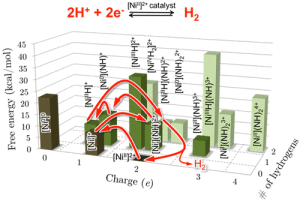The Electrochemical Society hosted Dr. Reza Nazemi’s live webinar, “Designing materials and systems for decarbonizing chemicals and water industries,” on March 15, 2023. Dr. Nazemi took audience questions during a live Question and Answer session at the end of the presentation. He kindly answered, in writing, questions not answered during the broadcast. Find these responses below.
View Dr. Reza Nazemi’s Webinar
Image: CC0 Public Domain
Researchers at Los Alamos National Laboratory (LANL) are taking a closer look at fuel cell catalysts in hopes of finding a viable alternative to the expensive platinum and platinum-group metal catalysts currently used in fuel cell electrodes. Developments in this area could lead to more affordable next-generation polymer electrolyte fuel cells for vehicles.
The research, led by ECS fellow Piotr Zelenay, looks at the fuel cell catalysts at the atomic level, providing unique insight into the efficiency of non-precious metals for automotive and other applications.
“What makes this exploration especially important is that it enhances our understanding of exactly why these alternative catalysts are active,” Zelenay says. “We’ve been advancing the field, but without understanding the sources of activity; without the structural and functional insights, further progress was going to be very difficult.”
This from LANL:
Platinum aids in both the electrocatalytic oxidation of hydrogen fuel at the anode and electrocatalytic reduction of oxygen from air at the cathode, producing usable electricity. Finding a viable, low-cost PGM-free catalyst alternative is becoming more and more possible, but understanding exactly where and how catalysis is occurring in these new materials has been a long-standing challenge. This is true, Zelenay noted, especially in the fuel cell cathode, where a relatively slow oxygen reduction reaction, or ORR, takes place that requires significant ‘loading’ of platinum.
Researcher from Stanford University have developed a new device that has made water-splitting more practical and boosted efficiency levels to an unprecedented 82 percent.
With just one catalyst, the novel water-splitting device can continuously generate hydrogen and oxygen for more than 200 hours with a steady input of just 1.5 volts of electricity.
Through this new device, researchers can produce renewable sources of clean-burning hydrogen fuel.
The Stanford researchers are using just one catalyst instead of the traditional two in water-splitting processes, which allows the cost to drop significantly.
“For practical water splitting, an expensive barrier is needed to separate the two electrolytes, adding to the cost of the device. But our single-catalyst water splitter operates efficiently in one electrolyte with a uniform pH,” said Haotian Wang, lead author of the study and graduate student at Stanford.

Using a desktop computer, scientists can query the model about the thermodynamic properties needed to create the desired catalysts. They can use those parameters to inform experimentalists in their synthetic work.
Image: Accounts of Chemical Research
We’re one step closer to transitioning renewable energy sources from intermittent to sustainable with this new development from Pacific Northwest National Laboratory.
Scientists are eliminating all of the unnecessary detours when dealing with molecular catalysts by elaborating on a strategy to map the catalytic route. With this strategy, researchers can modify just one part of a catalyst and see how that affects everything – including all the side reactions.
“We now know how catalysts with desired properties will behave in a given circumstance before we ever leave the computer. By working backwards, we can even ask which catalysts are the best performers for a set of conditions. We are on the verge of designing molecular electrocatalysts in silico — or conducting research by means of computer modeling,” said study co-leader, Dr. Simone Raugei.


